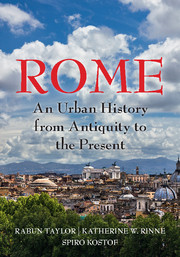Book contents
- Frontmatter
- Dedication
- Epigraph
- Contents
- List of Illustrations
- Acknowledgments
- Map
- INTRODUCTION
- 1 A BEND IN THE RIVER
- 2 A STORYBOOK BEGINNING
- 3 IDEOLOGICAL CROSSFIRE
- 4 BIG MEN ON THE CAMPUS
- 5 RES PUBLICA RESTITUTA
- 6 MEMORIALS IN MOTION: SPECTACLE IN THE CITY
- 7 THE CONCRETE STYLE
- 8 REMAKING ROME'S PUBLIC CORE: I
- 9 REMAKING ROME'S PUBLIC CORE: II
- 10 CRISIS AND CONTINUITY
- 11 RUS IN URBE: A GARDEN CITY
- 12 ADMINISTRATION, INFRASTRUCTURE, AND DISPOSAL OF THE DEAD
- 13 MAPPING, ZONING, AND SEQUESTRATION
- 14 TETRARCHIC AND CONSTANTINIAN ROME
- 15 TROPHIES AND TITULI: CHRISTIAN INFRASTRUCTURE BEFORE CONSTANTINE
- 16 WALLS MAKE CHRISTIANS: FROM FOURTH TO FIFTH CENTURY
- 17 A TALE OF TWO ROMES
- 18 THE ROME OF GOTHS AND BYZANTINES
- 19 CHRISTIAN FOUNDATIONS
- 20 FROM DOMUS LATERANI TO ROMANUM PALATIUM
- 21 THE LEONINE CITY: ST. PETER'S AND THE BORGO
- 22 VIA PAPALIS, THE CHRISTIAN DECUMANUS
- 23 THE URBAN THEATERS OF IMPERIUM AND SPQR
- 24 HOUSING DAILY LIFE
- 25 CHAOS IN THE FORTIFIED CITY
- 26 THE TIBER RIVER
- 27 HUMANIST ROME, ABSOLUTIST ROME (1420–1527)
- 28 PLANNING COUNTER REFORMATION ROME
- 29 PROCESSIONS AND POPULATIONS
- 30 MAGNIFICENT PALACES AND RHETORICAL CHURCHES
- 31 NEOCLASSICAL ROME
- 32 PICTURING ROME
- 33 REVOLUTION AND RISORGIMENTO
- 34 ITALIAN NATIONALISM AND ROMANITÀ
- 35 A CITY TURNED INSIDE OUT
- Glossary of Persons, Places, and Terms
- Works Cited
- Index
35 - A CITY TURNED INSIDE OUT
Published online by Cambridge University Press: 05 July 2016
- Frontmatter
- Dedication
- Epigraph
- Contents
- List of Illustrations
- Acknowledgments
- Map
- INTRODUCTION
- 1 A BEND IN THE RIVER
- 2 A STORYBOOK BEGINNING
- 3 IDEOLOGICAL CROSSFIRE
- 4 BIG MEN ON THE CAMPUS
- 5 RES PUBLICA RESTITUTA
- 6 MEMORIALS IN MOTION: SPECTACLE IN THE CITY
- 7 THE CONCRETE STYLE
- 8 REMAKING ROME'S PUBLIC CORE: I
- 9 REMAKING ROME'S PUBLIC CORE: II
- 10 CRISIS AND CONTINUITY
- 11 RUS IN URBE: A GARDEN CITY
- 12 ADMINISTRATION, INFRASTRUCTURE, AND DISPOSAL OF THE DEAD
- 13 MAPPING, ZONING, AND SEQUESTRATION
- 14 TETRARCHIC AND CONSTANTINIAN ROME
- 15 TROPHIES AND TITULI: CHRISTIAN INFRASTRUCTURE BEFORE CONSTANTINE
- 16 WALLS MAKE CHRISTIANS: FROM FOURTH TO FIFTH CENTURY
- 17 A TALE OF TWO ROMES
- 18 THE ROME OF GOTHS AND BYZANTINES
- 19 CHRISTIAN FOUNDATIONS
- 20 FROM DOMUS LATERANI TO ROMANUM PALATIUM
- 21 THE LEONINE CITY: ST. PETER'S AND THE BORGO
- 22 VIA PAPALIS, THE CHRISTIAN DECUMANUS
- 23 THE URBAN THEATERS OF IMPERIUM AND SPQR
- 24 HOUSING DAILY LIFE
- 25 CHAOS IN THE FORTIFIED CITY
- 26 THE TIBER RIVER
- 27 HUMANIST ROME, ABSOLUTIST ROME (1420–1527)
- 28 PLANNING COUNTER REFORMATION ROME
- 29 PROCESSIONS AND POPULATIONS
- 30 MAGNIFICENT PALACES AND RHETORICAL CHURCHES
- 31 NEOCLASSICAL ROME
- 32 PICTURING ROME
- 33 REVOLUTION AND RISORGIMENTO
- 34 ITALIAN NATIONALISM AND ROMANITÀ
- 35 A CITY TURNED INSIDE OUT
- Glossary of Persons, Places, and Terms
- Works Cited
- Index
Summary
MUSSOLINI'S ARMY INVADED ETHIOPIA IN 1935 AND CLAIMED IT FOR the Fascist empire the following year. Envisioning a new Roman empire originating in Africa (Libya had been an Italian colony since 1911), he announced his intention to hold a universal exposition of art, science, and work at Rome – an “Olympics of Civilization.” Disregarding his 1931 piano regolatore, he chose a site south of Rome for the Esposizione Universale di Roma, or EUR ’42. This fairground, he vowed, would become the permanent nucleus of a new city, neither an extension of Rome nor its suburb. The Eternal City, it seems, was proving an eternal compromise. He wanted to build his ideal Fascist city from the ground up, and EUR ’42 was his opportunity. Partitioned on a rectilinear grid and transected by a broad cardo and decumanus, its orthogonal plan evoked an ancient Roman colony more than Rome itself. Rome's recolonization of the Mediterranean would begin here (Fig. 221).
Workers broke ground in 1937, but when Italy joined forces with the Nazis in 1940, the exhibition was canceled. By July 1943, when Allied forces bombed the outskirts of Rome, EUR ’42 had been abandoned. Two years on, Mussolini and Fascism had fallen. Construction recommenced in 1950, but far from being the monument that the posthumously dubbed “Sawdust Caesar” had envisioned, EUR (the name stuck, but not the date) became another Roman suburb, albeit one with grand aspirations.
Mussolini also oversaw three of Rome's largest urban propaganda projects in the 1930s – one each for sport, education, and entertainment. Confinedto Fascist Party members, these extravagant enclaves aimed to provide nearly self-sufficient, strictly controlled environments at varying distances outside the walls. Foro Mussolini, a “City of Sport,” opened in 1933. It housed the flagship school of Opera Nazionale Balilla, a national organization that molded ideal Fascist youths through rigorous sports programs. It was also an arena for massive spectacles exalting the regime. Mussolini hoped to stage the 1944 Olympics there as a capstone to EUR ’42. They too were canceled, but the dream came to oblique fruition when the venue, renamed Foro Italico, hosted the 1960 Olympics (Fig. 222).
- Type
- Chapter
- Information
- RomeAn Urban History from Antiquity to the Present, pp. 336 - 348Publisher: Cambridge University PressPrint publication year: 2016



